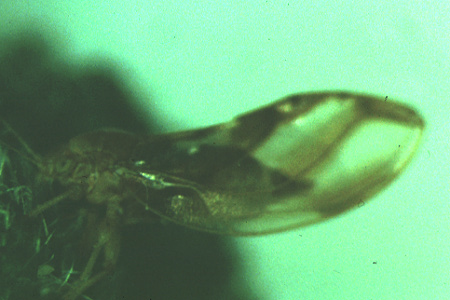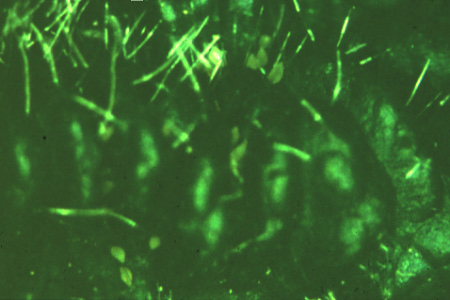 Blackberry psyllid
Blackberry psyllid Trioza tripunctata (Fitch)
I. Introduction: This species feeds only on blackberry and is
very common in the mid-Atlantic region. Psyllids resemble miniature
cicadas; they are sucking insects which hold the wings tent-like over
the body. The wings of this species are very characteristic; there are
three brown stripes running lengthwise. The length to the tip of folded
wings is 3.5-4 mm. The general color is yellow to brown. There are
elongate triangular projections from the front of the head, that are
between 1/2 and 1/3 as long as vertex (top of head). The antennae about
1 1/2 as long as width of head, with dark tips.
II. Biology: This species has a single generation and
overwinters in the adult stage. The psyllids overwinter on one of
various conifers (Pinus spp., Juniperus spp., Picea
spp. and Chamoecyparis spp.). In mid-May (mid-April in
Virginia) the adults begin to return to brambles. After adults have
been on brambles for 7-10 days, a distortion of the foliage becomes
apparent. Eggs are laid from approximately late May to mid July.
Females lay between 39 and 202 eggs. The following photograph shows
several blackberry psyllid eggs deposited in the folds of a tightly
curled blackberry leaf.

The nymphs are present from early June to late October, and adults
began emerging in early October. Nymphs are also responsible for some
leaf distortion and may be found inside curled leaves. Nymphs secrete
several types of waxy structures. Fruit spurs may be fed upon by
blackberry psyllid so that normal fruit fails to develop. In fall,
males and females are present in equal numbers but by March, the males
have disappeared.
The winter relationship with conifers is apparently obligatory. If
blackberries are one mile or more from conifers no psyllid damage will
be found. I have collected overwintering adults from various locations
in Virginia, West Virginia and Pennsylvania. The ninespotted lady
beetle has been recorded as a predator of this species (Caldwell 1938).
III.
Control: Malathion when psyllids appear. Avoid sites within 250
yards or so of conifer plantings.
IV. References